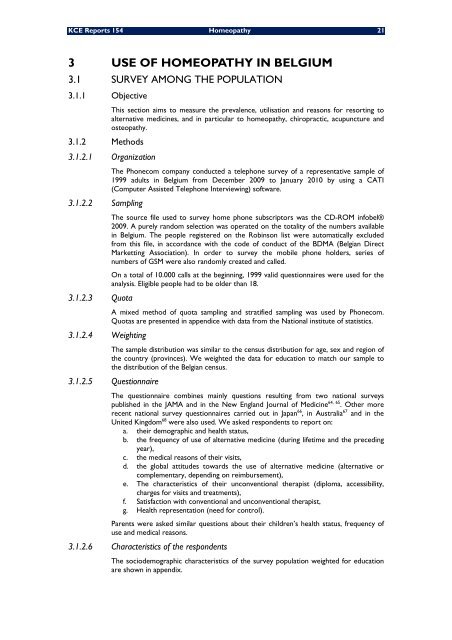Etat des lieux de l'homéopathie en Belgique - KCE
Etat des lieux de l'homéopathie en Belgique - KCE
Etat des lieux de l'homéopathie en Belgique - KCE
You also want an ePaper? Increase the reach of your titles
YUMPU automatically turns print PDFs into web optimized ePapers that Google loves.
<strong>KCE</strong> Reports 154 Homeopathy 21<br />
3 USE OF HOMEOPATHY IN BELGIUM<br />
3.1 SURVEY AMONG THE POPULATION<br />
3.1.1 Objective<br />
This section aims to measure the preval<strong>en</strong>ce, utilisation and reasons for resorting to<br />
alternative medicines, and in particular to homeopathy, chiropractic, acupuncture and<br />
osteopathy.<br />
3.1.2 Methods<br />
3.1.2.1 Organization<br />
The Phonecom company conducted a telephone survey of a repres<strong>en</strong>tative sample of<br />
1999 adults in Belgium from December 2009 to January 2010 by using a CATI<br />
(Computer Assisted Telephone Interviewing) software.<br />
3.1.2.2 Sampling<br />
The source file used to survey home phone subscriptors was the CD-ROM infobel®<br />
2009. A purely random selection was operated on the totality of the numbers available<br />
in Belgium. The people registered on the Robinson list were automatically exclu<strong>de</strong>d<br />
from this file, in accordance with the co<strong>de</strong> of conduct of the BDMA (Belgian Direct<br />
Marketting Association). In or<strong>de</strong>r to survey the mobile phone hol<strong>de</strong>rs, series of<br />
numbers of GSM were also randomly created and called.<br />
On a total of 10.000 calls at the beginning, 1999 valid questionnaires were used for the<br />
analysis. Eligible people had to be ol<strong>de</strong>r than 18.<br />
3.1.2.3 Quota<br />
A mixed method of quota sampling and stratified sampling was used by Phonecom.<br />
Quotas are pres<strong>en</strong>ted in app<strong>en</strong>dice with data from the National institute of statistics.<br />
3.1.2.4 Weighting<br />
The sample distribution was similar to the c<strong>en</strong>sus distribution for age, sex and region of<br />
the country (provinces). We weighted the data for education to match our sample to<br />
the distribution of the Belgian c<strong>en</strong>sus.<br />
3.1.2.5 Questionnaire<br />
The questionnaire combines mainly questions resulting from two national surveys<br />
published in the JAMA and in the New England Journal of Medicine 64, 65 . Other more<br />
rec<strong>en</strong>t national survey questionnaires carried out in Japan 66 , in Australia 67 and in the<br />
United Kingdom 68 were also used. We asked respon<strong>de</strong>nts to report on:<br />
a. their <strong>de</strong>mographic and health status,<br />
b. the frequ<strong>en</strong>cy of use of alternative medicine (during lifetime and the preceding<br />
year),<br />
c. the medical reasons of their visits,<br />
d. the global attitu<strong><strong>de</strong>s</strong> towards the use of alternative medicine (alternative or<br />
complem<strong>en</strong>tary, <strong>de</strong>p<strong>en</strong>ding on reimbursem<strong>en</strong>t),<br />
e. The characteristics of their unconv<strong>en</strong>tional therapist (diploma, accessibility,<br />
charges for visits and treatm<strong>en</strong>ts),<br />
f. Satisfaction with conv<strong>en</strong>tional and unconv<strong>en</strong>tional therapist,<br />
g. Health repres<strong>en</strong>tation (need for control).<br />
Par<strong>en</strong>ts were asked similar questions about their childr<strong>en</strong>’s health status, frequ<strong>en</strong>cy of<br />
use and medical reasons.<br />
3.1.2.6 Characteristics of the respon<strong>de</strong>nts<br />
The socio<strong>de</strong>mographic characteristics of the survey population weighted for education<br />
are shown in app<strong>en</strong>dix.

















